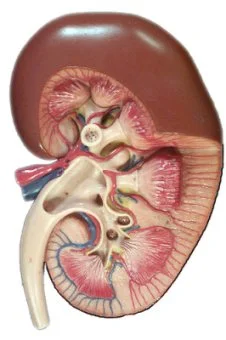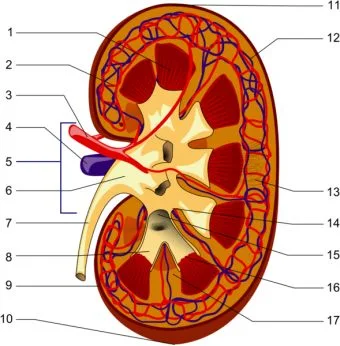
photo by EUSKALANATO
Feline Kidney Disease comes in a number of forms. They are discussed here.
Introduction
The main role of a cat's kidneys is to maintain a stable and constant condition in respect of the cat's body fluids (the homeostatic balance). They achieve this by filtering out and then secreting the unwanted products (Metabolites - for example urea) of the cats metabolism from the cat's blood and then excreting it from the cat in the form of urine (water plus the metabolites). Kidneys also regulate blood pressure, glucose metabolism and the process by which red blood cells are produced by sensing the concentrations of ions and compounds in the blood. "Metabolism" is the range of chemical reactions that take place in the body to sustain life.

Published under a Wikimedia license under the terms of the GNU Free Documentation license, Version 1.2 or any later version. Author: Piotr Michał Jaworski.
Feline Kidney Disease - The diseases
1. Feline Kidney Disease - Infection of the Kidney and Renal Pelvis
The "Renal Pelvis" is marked number 6 on the drawing above.
Pyelonephritis - this is a bacterial infection of the kidney and the urinary collecting system (the ducts and bladder) - the urinary tract. The infection can either arrive at the kidney by way of the bladder (ascending from the bladder) or less commonly the blood. The term Pyelonephritis is made up from "pyelum" meaning pelvis and "nephros" (Greek for kidney or nephro meaning "of the kidney") and "itis", which means inflammation. It can be acute and/or chronic. "Acute" means a sudden start and short course and "chronic" means long term.
{note: bacteria are single celled microorganisms. We can't see them but they are everywhere. For example, in one gram of soil there are 40 million bacteria. There are approx. ten times the number of bacteria cells on and in the human body than the number of human cells that make up the human body. The vast majority are made harmless by the body's immune system (human or cat) , some are not - src: Wikipedia}
The Feline Kidney Disease of Pyelonephritis causes pain in the abdomen and pain in urinating with tenderness in the bladder and the side of the kidney affected (src: Wikipedia). The pain is accompanied by fever and vomiting. The cat is hunched and stiff legged when walking. The urine can be bloody.
When the disease becomes chronic (acute infection does not necessarily become a chronic infection however) the disease spreads in a subtle/stealthy manner causing weight loss and ultimately signs of kidney failure (see below).
2. Feline Kidney Disease - Nephritis and Nephrosis
Nephritis means inflammation of the kidney (the cause is irrelevant). It can be caused by:
- infections
- toxins (a poisonous substance produced by a living organism e.g. snake bite, bee sting)
- drugs (drugs given to treat another illness)
- poisons (this includes toxins but can be from any source, e.g. rat poison)

- viruses
The most common type of Nephritis is Chronic (long term) Interstitial (situated between the cells) Nephritis.
Another form of nephritis is Glomerulonephritis (glomerular nephritis or GN). It is the inflammation of the glomeruli of the kidney (glomerulus is the singular - see the drawing on the right hand side of a glomerulus published under a Wikimedia commons license) (the small blood vessels).
This is at the heart of the filtration system of the cat's kidney (and any vertebrate's kidney). The causes could be:
- immune system malfunction
- feline leukemia
- feline infectitious peritonitis
- feline progressive polyarthritis
- cancer
Another form is Amyloidosis, which refers to range of conditions in which amyloid proteins are deposited on organs, including the cat's kidneys and tissues causing disease. Most amyloid proteins are part of the cat's blood plasma (the liquid part of blood in which the blood cells and other substances are suspended).
Nephrosis is a Feline Kidney Disease (and other vertebrates) that involves the destruction of the Nephrons on the kidney (see diagram above No.13). Thus results in loss of function. Nephrotic Syndrome is a condition in which protein leaks through the kidney filtering system and out into the urine. This results in low serum protein (serum= blood plasma with clotting factors removed) and fluid accumulates below the skin and inside the abdomen (because the fluid passes out of the blood stream to the body). In humans the fluid accumulates in the ankles and legs. Diagnosis is not straightforward as these symptoms are present with other diseases.
In humans Chronic Nephrosis causes infections, high cholesterol and clotting blood in the veins.
3. Feline Kidney Disease - Kidney failure
When this happens the kidneys are unable to remove the waste products of metabolism from the body resulting in a build up of toxic material in the cat's body.
When kidney failure is acute (sudden start and short duration) it can be caused by:
- blockage in the urinary tract
- trauma (injury) - bladder rupture or pelvic fracture
- shock
- blood clot of an artery (renal artery particularly)
- reduced blood to the kidney due to heart failure
- poison particularly antifreeze
- Nephrosis (see above)
- Nephritis (see above)
- infections (FIV and FeLV for example)
- drugs that are poisonous to the kidney and heavy metals for example such as lead and mercury
- old age
The signs and symptoms of feline kidney disease leading to kidney failure occur late in the day when up to 70% of the nephrons (see diagram above no. 13) have been destroyed. The symptoms are:
- high level of urination and drinking (supply plenty of fresh water)
- apathy (due to poisoning of the cat's body by the retention of the waste products of metabolism - uremic poisoning)
- sluggishness (due to poisoning of the cat's body by the retention of the waste products of metabolism)
- loss of appetite
- loss of weight
- dry coat - unkempt appearance
- tongue and gum ulcers
- brownish tongue
- ammonia smelling breath
- vomiting yellowish fluid
- diarrhea
- anemia
- bleeding of the intestine
- coma (terminal)
Feline Kidney Disease - Managing cats with CRD
Acute kidney failure can be treated (provided the underlying cause is diagnosed and as quickly as possible) and the cat returned to health. Cats with chronic kidney failure usually have damaged kidneys but can live a decent life. It is a question it seems of managing to best advantage the remaining functionality of the kidneys. This is best done through correct diet suitable to a cat with CRD (Chronic Renal Disease). The conventional view is a high quality and low in protein (Hills k/d for example is recommended by Cat Owner's Home Veterinary Handbook by Drs Carlson and Giffin). These doctors also recommend:
- Vitamin B supplements (to replace loses through urine elimination)
- sodium carbonate if the acid/base balance needs to be corrected
- phosphorus binder to lower the phosphorus levels in the blood serum to restore balance
A veterinarian, who I have mentioned several times in other posts is Dr. Hodgkins DVM. She believes that the conventional view referred to above (i.e. a low protein diets) originated in the treatment of CRD dogs. Dogs are omnivores and the diet works. In cats it seems to work less effectively as a cat needs a high protein diet being a carnivore. In addition low protein commercial diets are often in the form of dry food (kibble) which carries its own problems in terms of urinary tract health. For example the cat needs to drink more and if not sufficiently it can cause bacterial infections. Cats eating dry "kibble" are relatively dehydrated than cats eating high moisture diets. IN fact, chronic dehydration through eating dry cat food for a long time can contribute to CRD, Dr. Hodgkins believes.
Dr Hodgkins feels that veterinarians today can do better in the management of cats suffering from feline kidney disease. I think it fair to say (and this I my view only of course) that she is an independent voice. Whereas a number scientists/veterinarians either favor or work for the big pet food manufacturers whose research is geared towards promoting the kind of pet food that make them more profit. I don't want to water down Dr. Hodgkins's conclusions so I would recommend her book "Your Cat". The ISBN number is 9780312358013 18.99.
In short for the proper management of cat with feline kidney disease she recommends/concludes:-
- better research is need into a diet that manages CRD cats (it is currently biased it seems - my view).
- the classic low protein diet prescribed for CRD cats is unsuitable as it is unappetizing (eating less as a result) and cats require protein for energy and the repair of the body. This is obviously vital in a sick cat.
- the concept of lowering protein levels to lower phosphorus levels is incorrect. It is better to maintain proper protein levels in the diet (a wet food diet) and to lower phosphorus levels with added phosphate binders. Dr. Hodgkins also recommends cooked and chopped egg white to the wet food high protein diet (this performs the same function as phosphate binders it seems).
- antibiotics can be prescribed where a urinary tract infection is a result of CRD or in part a cause of it
- feline anemia may be present in a cat with CRD
- kidney transplants are now available at a price
- early diagnosis is vital in proper treatment and management of feline kidney disease.
- Persian (high incidence) - see Persian cat health problems
- Himalayans
- Exotic Shorthair
- Selkirk Rex
- Maine Coon - see Maine Coon cat health
Update 25-8-08:
A company called Pala-Tech Laboraties™ produces a number of products including Cranberry Plus Chewable Tablets and Cranberry Plus Granules, which are dietary supplements for the maintenance of urinary tract health. The NHS (National Health Service) in the UK did some research on the efficacy of cranberries for the prevention and treatment of urinary tract infections (UTIs) in people and found that there was some evidence that cranberries may decrease the number of "symptomatic UTIs" over a period of 12 months. You decide.
From Feline Kidney Disease to Insurance for Cat health problems
Feline Kidney Disease - Sources:
- Cat Owner's Home Veterinary Handbook by Drs Carlson and Giffin
- Wikipedia for definitions primarily
- www.merriam-webster.com
- http://dictionary.reference.com
- http://renux.dmed.ed.ac.uk
- Your Cat by Dr Hodgkins DVM



check out Azoydyl-- it reversed our cats' declining kidney numbers (Dr. Fong at SF Vet)
ReplyDelete